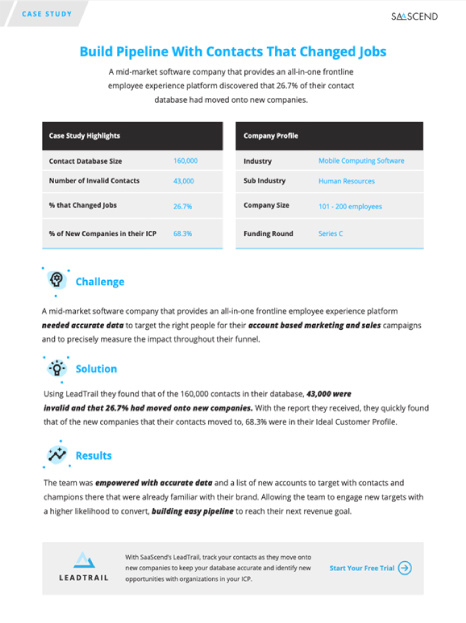People do business with people that they know, like, and trust. Which is why sales leaders can notice when one of their top new business pipeline sources is former customers who move to a new account that can advocate on their behalf. To capitalize on these opportunities though, your teams have to be doing job change tracking of your former customers and champions.
Why Job Change Tracking Is Critical
As contacts change jobs, their former data is no longer valid and nowadays job changes happen all the time whether it is by the contact’s choice or because of layoffs. The average employee tenure in B2B tech is 12 – 18 months. As your contacts change jobs, your data is decaying or becoming obsolete.
According to Marketing Sherpa, the average monthly contact data decay rate is 2.1%, that means your entire database decays at a rate of about 25.2% annually. If you have a database size of 40,000 contacts that means 10,080 of them will be invalid in 12 months. If your database is not being updated regularly and you have data that is two or more years old, that results in even a higher percentage of your contacts being invalid (Fig 1).

Figure 1, Data Decay Increasing Overtime. As the average monthly data decay rate is 2.1%, this multiplies over time to equal about 25.2% annually. Meaning that if data is not updated regularly, the amount of invalid data is only increasing as time goes on.
On the marketing side data decay inhibits your team’s ability to reach the right people at the right time. If your contacts have not been updated in 6 months, your team could be marketing to a database where 12.6% of them are invalid, resulting in increasing bounce rates. If they are doing any kind of account based marketing and have targeted ads running to a contact list that has not been updated in six months, you can expect that over ten percent of that database is not getting reached because the data is invalid.
On the sales side, data decay results in lost opportunities. Of the 10,080 contacts that became invalid over 12 months from our previous example, if even 1% of them converted to customers that would be about 100 new customers. If you have an average deal size of $20,000, that would equal about $2M in revenue (Fig 2).

Figure 2, The Revenue Lost from Data Decay.
Invalid data is costing you missed opportunities and for marketing dollars to be wasted on targeting contacts that are no longer there. Since data decay increases as time goes on, the older your data is the worse these problems compound. To fight data decay and empower your team with intel of when contacts move onto new companies, there is job change tracking.
Building Pipeline Fast with Former Customers
Many salespeople already understand the value of tracking when their champions and former customers change jobs, so it is most likely that they are doing this manually with LinkedIn Sales Navigator, but they are not being proactively notified about it and the tracking is happening outside of the CRM.
Sales is aware that if they have a champion that already knows, likes, and trusts them at a new account, then starting a conversation and closing that new account is going to be much easier than if they were reaching out cold without any former relationship.
Questions to consider regarding job change tracking are:
-
-
- How old is the majority of my contact database?
- When was the last time our contact data was updated?
- How many of our former customers and champions already have moved onto new companies?
- Which of those new companies are in our ICP?
- Is our sales team currently trying to do job change tracking on their own? If yes, how are they currently doing this process?
-
One of our customers, a mid-market software company providing an all-in-one frontline employee experience platform, has a database of 160,000 contacts. We used our job change tracking solution, LeadTrail for them and they discovered that 26.7% of their database had moved onto new companies. Of the new companies that were listed, 68.3% were in their Ideal Customer Profile.
With this new intel, their sales team was able to start reaching out to those new organizations and build pipeline fast because they had former contacts on the buying committee that they already had a relationship with.
Job Change Tracking Solution
We recommend doing job change tracking for your organization as it keeps your data accurate and empowers your sales team with intel to enter into new business opportunities faster during their sales process. Doing this manually takes up your team’s time, can result in siloed data, and often cannot be done at a fast enough rate.
We are offering a new job change tracking solution, LeadTrail, to help teams overcome this challenge. You can sign up for a trial and try it out with 250 of your contacts here.

250 RECORDS FREE
Build Easy Pipeline as Champions Change Jobs


